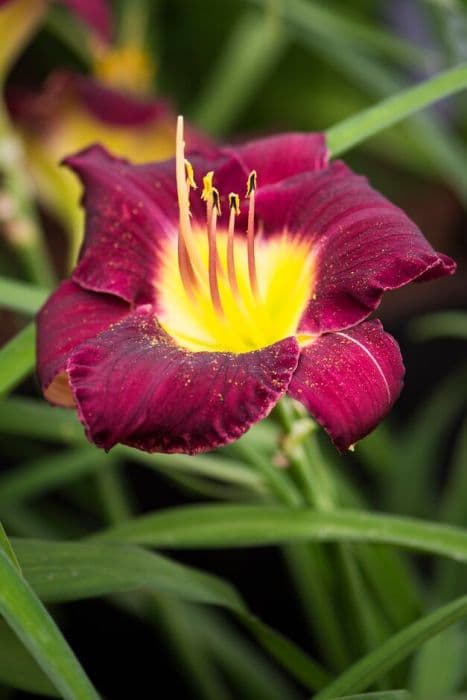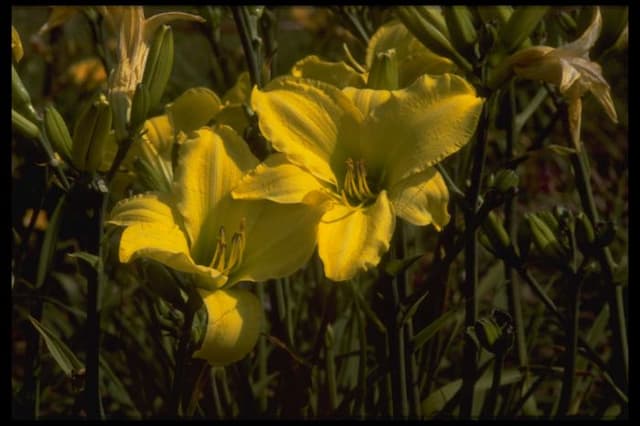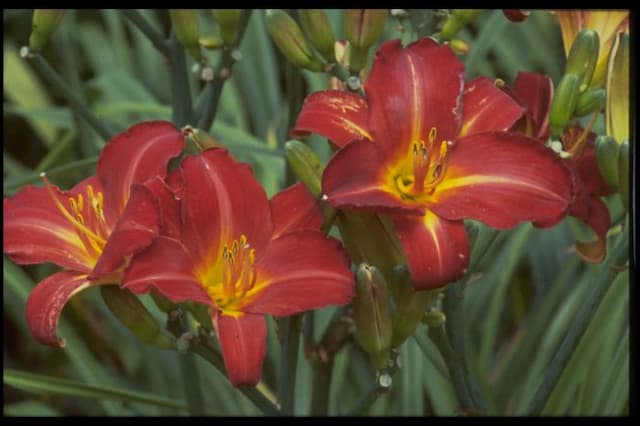Daylily Hemerocallis 'Whichford'

ABOUT
Hemerocallis 'Whichford', commonly known as the Whichford daylily, showcases a striking appearance with its vibrant and colorful flowers. The plant bears large blooms that are characteristically trumpet-shaped, exuding a sense of elegance and beauty in the garden. These flowers can display a variety of hues, but typically, the Whichford daylily will have petals that boast a warm, inviting color palette, perhaps with shades of gold, orange, or rich creams. The throat of the flower, or the innermost part of the bloom, often contrasts with the outer petals, potentially featuring a deeper or more vivid color that draws attention and accentuates the flower's form. The daylilies are supported by long, sturdy stalks that arise from a clump of arching, blade-like leaves. These leaves are typically bright green, providing a lush backdrop for the colorful display above. The foliage is dense, creating an attractive and textured ground cover even when the plant is not in bloom. The leaves can also be seen gracefully curving towards the ground, softening the overall appearance of the plant. Daylilies are known for their blooms' daily lifecycle, with each individual flower opening up in the morning and withering away by nightfall. Yet, the plant produces numerous buds on each stalk, ensuring a continuous succession of new flowers throughout the blooming season and maintaining a dynamic and ever-changing display.
About this plant
 Names
NamesFamily
Hemerocallidaceae
Synonyms
Daylily
Common names
Hemerocallis 'Whichford'.
 Toxicity
ToxicityTo humans
Daylilies, such as Hemerocallis 'Whichford', are not typically considered toxic to humans and are in fact often eaten in certain cuisines with the flowers being consumed after cooking. However, it is important to note that some individuals may have allergies or sensitivities to daylilies, which could result in symptoms such as gastrointestinal upset if ingested. Always exercise caution and be sure of correct identification before consuming any plant parts. If an adverse reaction is experienced, it is advisable to seek medical attention.
To pets
Daylilies are known to be highly toxic to cats. Even small amounts can cause severe kidney damage. The symptoms of daylily poisoning in cats might include vomiting, lethargy, kidney failure, or lack of appetite. If you suspect that your cat has eaten any part of a daylily, immediate veterinary attention is crucial. There is less evidence of toxicity in dogs, but to be cautious, it is best to prevent all pets from ingesting plants that have potential for toxicity.
 Characteristics
CharacteristicsLife cycle
Perennials
Foliage type
Deciduous
Color of leaves
Green
Flower color
Varies
Height
2 feet (60 cm)
Spread
2 feet (60 cm)
Plant type
Herb
Hardiness zones
Varies
Native area
Asia
Benefits
 General Benefits
General Benefits- Easy to grow - The daylily is known for being low maintenance and adaptable to a variety of growing conditions.
- Drought tolerant - Once established, it can withstand periods of low water, making it suitable for dry climates and water-conserving gardens.
- Bright flowers - Produces vibrant, colorful blooms that enhance the aesthetic appeal of any garden.
- Attracts pollinators - Flowers of the daylily attract bees and butterflies, which can help pollinate other plants in the garden.
- Edible parts - Some daylilies have edible flowers, which can be used in salads and as a garnish.
- Varied uses - Can be used in mixed borders, as groundcover, or for erosion control on slopes.
- Long blooming period - The plant offers a long flowering season, with some cultivars reblooming throughout the summer.
 Medical Properties
Medical PropertiesThis plant is not used for medical purposes.
 Air-purifying Qualities
Air-purifying QualitiesThis plant is not specifically known for air purifying qualities.
 Other Uses
Other Uses- Edible Flowers: The blooms of the daylily are edible and can be used in salads or as an edible garnish on dishes.
- Crafts: Dried daylily flowers can be used in floral arrangements or potpourri mixes.
- Natural Dye: The petals of daylilies contain pigments that can be used to produce yellow, orange, or red natural dyes for textiles or craft projects.
- Companion Planting: Daylilies can be planted alongside vegetables to add beauty to a vegetable garden and potentially improve pollination of vegetable plants.
- Culinary Thickener: The dried and ground root can be used as a thickening agent in soups and sauces, similar to arrowroot or cornstarch.
- Fish Poisons: Historically, certain parts of daylilies have been used by indigenous people to stun fish, making them easier to catch.
- Water Gardening: Daylilies are sometimes used at the edges of water gardens due to their tolerance for moist soil conditions.
- Wine Making: The flowers of daylilies can be fermented to produce a lightly flavored country wine.
- Ikebana: The Japanese art of flower arrangement, or Ikebana, often uses daylilies for their graceful forms and vibrant colors.
- Erosion Control: Daylilies have dense root systems that help stabilize soil and prevent erosion on slopes.
Interesting Facts
 Feng Shui
Feng ShuiThe Daylily is not used in Feng Shui practice.
 Zodiac Sign Compitability
Zodiac Sign CompitabilityThe Daylily is not used in astrology practice.
 Plant Symbolism
Plant Symbolism- Resilience and Adaptability: Daylilies, including the Hemerocallis 'Whichford', are known for their ability to thrive in various conditions, symbolizing the capacity to endure and adapt to life's changes.
- Motherhood and Fertility: With their prolific blooming nature, daylilies often represent fertility and abundance, making them symbols of motherhood and creativity.
- Transience of Life: The individual flowers of a daylily typically last only one day, symbolizing the ephemeral nature of life and the importance of living in the present.
- Forgiveness: The constant renewal and blooming of new flowers can represent the idea of forgiveness and a fresh start.
 Water
WaterDaylilies, like Hemerocallis 'Whichford', prefer consistent moisture, especially during the active growth and blooming season. You should water the plant deeply once a week, allowing the water to penetrate to a depth of 8 to 10 inches. In dry spells or hot weather, increase watering to twice a week. Each watering session should consist of about 1 to 1.5 gallons for each plant, ensuring you water at the base to keep the foliage dry and reduce the risk of disease. Reduce watering frequency during the fall and winter when the plant is dormant.
 Light
LightDaylilies, including Hemerocallis 'Whichford', thrive in full sun, which means at least 6 to 8 hours of direct sunlight per day. They can tolerate partial shade, especially in the afternoon, but flowering may be reduced in less light. The best location for planting is an area that receives bright morning sun and some protection from the intense heat of late afternoon sun.
 Temperature
TemperatureDaylilies, such as Hemerocallis 'Whichford', are hardy and adaptable to a wide range of temperatures. They can survive in areas with winter temperatures down to -20°F and summer temperatures up to 90°F or higher. The ideal growing temperatures for daylilies are between 55°F and 75°F. Daylilies are quite resilient and can withstand temporary extremes outside these ranges.
 Pruning
PruningDaylilies such as Hemerocallis 'Whichford' should be pruned to remove spent flower stalks and to deadhead individual spent blooms, which encourages reblooming. Pruning is also essential at the end of the blooming season or in the fall to remove any dead or yellowing foliage, which helps prevent disease. In early spring, remove old foliage from around the base of the plants. Periodic removal of dead material throughout the growing season helps the plant to maintain vigor and aesthetic appeal.
 Cleaning
CleaningAs needed
 Soil
SoilDaylilies thrive in moderately fertile, well-drained soil with a pH of 6.0 to 6.5. A mix consisting of loamy garden soil, compost, and a bit of sand for improved drainage creates an ideal growing medium for Hemerocallis 'Whichford'.
 Repotting
RepottingDaylilies, including Hemerocallis 'Whichford', do not require frequent repotting and can thrive outdoors for several years without being disturbed. They should be divided and repotted only when clumps become overcrowded, typically every 3 to 5 years.
 Humidity & Misting
Humidity & MistingDaylilies such as Hemerocallis 'Whichford' are tolerant of a range of humidity levels and do well in average garden conditions without the need for specific humidity adjustments.
 Suitable locations
Suitable locationsIndoor
Use bright indirect light, well-draining soil, moderate watering.
Outdoor
Full sun to partial shade, well-draining soil, divide every few years.
Hardiness zone
3-9 USDA
 Life cycle
Life cycleThe plant commonly known as Daylily 'Whichford' begins its life cycle when a seed germinates, typically requiring a warm-cold stratification period to break dormancy. Once the seedling emerges, it grows into a clump of grass-like foliage, with the plant focusing on accumulating energy and developing a robust root system in its initial years. As the Daylily matures, it forms a larger clump with increased foliage and begins to produce flower buds. In late spring to early summer, the buds bloom into the characteristic trumpet-shaped flowers, which famously last only one day, with each individual flower blooming once and then withering. After the flowering period, the plant sets seed if pollinated; however, propagation is often done by dividing the root clump instead of growing from seed. Eventually, the Daylily enters a period of dormancy in late fall or winter, with foliage dying back, to emerge again the following spring.
 Propogation
PropogationPropogation time
Late summer to early fall
Propogation: The Hemerocallis 'Whichford', commonly known as the Daylily 'Whichford', is best propagated by division. This method is typically carried out in late summer to early fall, after the blooming period has ended, to ensure the plant has enough time to establish itself before the onset of winter. When propagating daylilies, gardeners should dig up the entire clump and gently separate the fans, which are individual plants with their own roots and foliage. Each fan should have a good root system and at least two or three leaves. These divisions can be immediately replanted in well-draining soil, with the crown placed about 1 inch (2.54 cm) below the ground surface. Water the newly planted divisions thoroughly to help establish them. This simple and effective technique is the most popular because it maintains the cultivar's characteristics and invigorates the parent plant.









